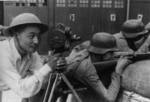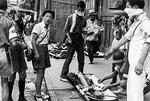Wang Xiaoting
| Surname | Wang |
| Given Name | Xiaoting |
| Died | 9 Mar 1981 |
| Country | United States, China |
| Category | Photography |
| Gender | Male |
Contributor: C. Peter Chen
ww2dbaseWang Xiaoting (also known as Wang Haisheng or H. S. "Newsreel" Wong) was born in the United States in 1900. He began working in the news and photojournalism industry in the US in 1920. Between 1923 and 1925, he was a member of an American expedition to Mongolia, Xinjiang, and Tibet regions of China. In May 1929, he was on assignment in Beiping, China. In 1931, the Shanghai-based newspaper Shun Pao hired him as the director of the photography department; later in the same year, he was sent on assignment to document the life of ethnic minority communities in China.
ww2dbaseWhen WW2 began, Wang was under the employment of the US firm Hearst Metrotone News. On 28 Aug 1937, Wang and other cameramen working for various agencies gathered atop the Butterfield & Swire building in Shanghai on false rumors that the Japanese was to bomb a Chinese Army blockade along the Huangpu River at 1400 hours. Seeing that no attack materialized, all cameramen but Wang departed by 1500 hours, seeking other opportunities. At 1600 hours, 16 Japanese carrier aircraft arrived, dropping bombs on the South Station in Shanghai, killing 700 civilians and the immediate area who were waiting for an overdue train bound for Hangzhou, Zhejiang Province, China (Japanese Navy later announced that the pilots had mistaken the large crowd for a troop concentration). He drove in his personal automobile to the station, and noted the destruction:
ww2dbaseThe next morning, he took the newsreel footage to the offices of China Press, where it was decided that it was worthy of sending to the Hearst office in New York, New York, United States. The newsreel traveled by US Navy warship to Manila, Philippine Islands and then by a Pan American World Airways aircraft the rest of the way. By mid-Sep 1937, images of the crying child was seen in theaters and in magazines. The most popularly printed still from the newsreel was titled "Chinese Baby", "Shanghai Baby", "Bloody Saturday", and "Bloody Sunday". This image brought Wang fame, particularly in Chinese circles, and the image was produced widely in fundraising efforts. This image was later voted by Life magazine readers as one of the ten "Pictures of the Year" for 1937. In 1944, this particular newsreel sequence was used within the Frank Capra film "The Battle of China".
ww2dbaseShortly after, Japan accused Wang of staging the photograph, citing that the man who tended to the injured child was not the father, but Wang's colleague. Japan put a bounty of US $50,000 on Wang's head. Fearing for the safety of his family, he relocated his family to Hong Kong while he remained in China to document the war. He filmed the Battle of Xuzhou and the aerial bombing of Guangzhou.
ww2dbaseAfter the war, Wang returned to the United States. From 1950 and into the 1970s, he was employed by Metro-Goldwyn-Mayer (MGM). In the 1970s, MGM dispatched him to Taipei, Taiwan, Republic of China on semi-permanent special assignment. He passed away from diabetes in Taipei in 1981.
ww2dbaseSource: Wikipedia
Last Major Revision: Jan 2017
Wang Xiaoting Interactive Map
Photographs
 |  |
Photographs Taken by Wang Xiaoting
 |  |
Wang Xiaoting Timeline
| 28 Aug 1937 | Wang Xiaoting, also known as H. S. "Newsreel" Wong, filmed the scenes at South Station in Shanghai, China immediately after a Japanese Navy aerial bombing. One of the stills featuring an injured and crying toddler, "Chinese Baby", would soon be seen by an estimated 25 million people world wide in the form of newsreels, newspapers, and magazines by the end of the year. |
| 9 Mar 1981 | Wang Xiaoting passed away in Taipei, Taiwan, Republic of China. |
Please consider supporting us on Patreon. Even $1 per month will go a long way! Thank you. Please help us spread the word: Stay updated with WW2DB: |
» Second Battle of Shanghai
» Bombing of Shanghai, Chongqing, and other Cities
- » 1,169 biographies
- » 337 events
- » 44,835 timeline entries
- » 1,244 ships
- » 350 aircraft models
- » 207 vehicle models
- » 376 weapon models
- » 123 historical documents
- » 261 facilities
- » 470 book reviews
- » 28,517 photos
- » 365 maps
Winston Churchill